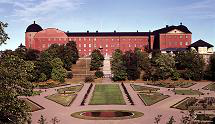Speaker
Description
Summary
The PANDA experiment will make use of cooled antiproton beams, available at the High Energy Storage Ring (HESR), of unprecedented quality that will be available at the Facility for Antiproton and Ion Research (FAIR) in Darmstadt, featuring up to 10^11 antiprotons and momentum in the 1.5 ÷ 15 GeV/c range.
An extensive physics program [1] is foreseen using the antiproton beam in combination with H target: spectroscopy of charmonium and of open charm mesons, search for gluonic excitations, spectroscopy of charmed baryons and study of nucleaon structure by measurement of time-like form factors, Drell-Yan and generalized parton distributions. Moreover using nuclear targets an investigation will be possible on modification of the properties of mesons embedded in nuclear medium and on properties of double hypernuclei.
This rich physics program asks for a general purpose apparatus [2] able to detect charged and neutral particles over a wide emission angle and to identify pions, kaons, protons as well as electrons and muons in a large momentum range from about 200 MeV/c up to 10 GeV/c with the target momentum resolution in the order of about 1%.
To deal these requests and taking into account the antiproton beam boost, the PANDA apparatus consists of two spectrometers: the Target Spectrometer (TS) surrounding the interaction point and the Forward Spectrometer (FS) covering the most forward angle.
The TS is based on a super-conducting solenoid with 2 T magnetic field showing a segmented iron yoke to allocate muon detectors. However, it will contain detectors in an onion shell like setup, covering the angles between 22° and 140°, including the Micro Vertex Detector (MVD), the STT (Straw Tube Tracker), the Cherenkov detectors (DIRC), the Time of Flight system (TOF) and the Electromagnetic Calorimeter (EMC).
Additional instrumentation is foreseen at both TS ends, the backward end cap EMC will cover angles up to 170°, and the forward end cap EMC, the 3 planar GEM stations and the DIRC disk will complete the TS extending the coverage polar angle down to 5° and 10° in the vertical and horizontal planes respectively.
Angles below these ones will be covered by the FS, based on a 2 Tm dipole magnet and equipped with Cherenkov detectors, shashlyk-type calorimeters and muon counters.
Further downstream the beam behind the FS, a luminosity monitor, based on HV-MAPS , is planned to measure the small polar angles of scattered antiprotons, corresponding to the Coulomb-nuclear interference region.
An additional modular setup is foreseen for the double hypernuclei study by removing the backward EMC and arranging a dedicated nuclear target station and detectors for the gamma spectroscopy.
The detectors of the PANDA apparatus are requested to be able to handle a nominal interaction rate of 2 x 10^7 /s with a continuous data transmission of the relevant information which includes a precise time stamp for each particle hit. A specific buffering process is performed at the early step and, finally the trigger selection occurs in computing nodes which access the buffers via a high bandwidth network fabric. This allows a high degree of flexibility in the choice of 'trigger' algorithms.
The reconstruction of charmed mesons can be pursued with the MVD with a spatial resolution better than 100 um along the antiproton direction and in the order of some tens in the perpendicular plane. Photons from many physics channels ask for a large dynamic range, from few MeV up to 10 GeV/c, for the electromagnetic calorimeter.
Limited material budget and radiation hardness are further requested for many detectors.
To cope with all these requirements innovative detector techniques have been applied as the cooling of the PbWO4 EMC [3] crystal down to -25°C which increase the light quantity of a factor of about 4 compared to room temperature, the stimulated recovery of the light yield worsening with the irradiation [4]. Straws working with a higher gas mixture pressure than similar systems [5], epitaxial silicon material for the MVD pixel devices [6] are additional applied solutions as well lightweight and low-Z materials as support mechanics.
Meanwhile the readout design is a challenge and specific solutions are under development as the custom ASICs for the silicon devices (ToPix [7] for the pixel part), pile-up recoovery method for the overlapping pulses of the EMC implemented in a FPGA for online data processing [8].
The design of PANDA is in an advanced stage and the R&D phase is approaching the end, as resulted by the most of the TDRs already completed [9][10], or under writing. In addition the production phase is already started for the Electromagnetic Calorimeter (EMC).
An overview of the PANDA apparatus will be presented.
References
[1] Physics Performance Report, (2009), http://arxiv.org/abs/0903.3905v1
[2] Full technical progress Report, http://www-panda.gsi.de/html/reports.php
[3] R.W. Novotny, Journal of Physics, Conference Series 404 (2012) 012063, doi:10.1088/1742-6596/404/1/012063
[4] V. Dormenev, Nucl. Instr. And Meth. In Phys. Res. A 632 (2010) 1082
[5] STT Technical Design Report,http://link.springer.com/content/pdf/10.1140/epja/i2013-13025-8
[6] Micro Vertex Detector Technical Design Report, (2012), http://arxiv.org/abs/1207.6581v2
[7] G. Mazza, Journal of Instrumentation, 2012 JINST 7 C02015
[8] H. Loener, Nucl. Instr. And Methods A, (2012), http://dx.doi.org/10.1016/j.nima.2012.10.007
[9] EMC Technical Design Report, (2008), http://arxiv.org/abs/0810.1216v1
[10] Magnets Technical Design Report, (2009), http://arxiv.org/abs/0907.0169

